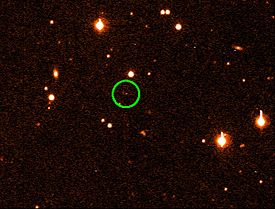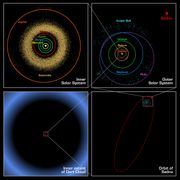90377 Sedna
2008/9 Schools Wikipedia Selection. Related subjects: Space (Astronomy)
 Sedna is located in the centre of the green circle
|
|
|
Discovery
|
|
|---|---|
| Discovered by | M. Brown, C. Trujillo, D. Rabinowitz |
| Discovery date | November 14, 2003 |
|
Designations
|
|
| MPC designation | 90377 Sedna |
| Alternative names | 2003 VB12 |
| Minor planet category |
Trans-Neptunian object detached object |
|
Orbital characteristics
|
|
| Epoch September 26, 1990 ( JD 2448160.5) | |
| Aphelion | 1.459×1014 m (975.56 AU) |
| Perihelion | 1.1393×1013 m (76.156 AU) |
| Semi-major axis | 7.8668×1013 m (525.86 AU) |
| Eccentricity | 0.855 |
| Orbital period | around 4,404,480 d (12,059.06 a) |
| Average orbital speed | 1.04 km/ s |
| Mean anomaly | 357.457° |
| Inclination | 11.934° |
| Longitude of ascending node | 144.514° |
| Argument of perihelion | 311.123° |
|
Physical characteristics
|
|
| Dimensions | 1,180–1,800 km |
| Mass | 8.3×1020–7.0×1021 kg (0.05–0.42 Eris) |
| Mean density | 2.0? g/ cm³ |
| Equatorial surface gravity | 0.33-0.50 m/s² |
| Escape velocity | 0.62-0.95 km/s |
| Sidereal rotation period |
0.42 d (10 h) 1 |
| Albedo | >0.2? |
| Temperature | below 33 K |
| Spectral type | (red) B-V=1.24; V-R=0.78 |
| Apparent magnitude | 20.4 ( Perihelic) |
| Absolute magnitude | 1.56 |
90377 Sedna (pronounced /ˈsɛdnə/ sed'-nə) is a trans-Neptunian object, discovered by Michael Brown ( Caltech), Chad Trujillo ( Gemini Observatory) and David Rabinowitz ( Yale University) on November 14, 2003. At the time of its discovery it was 89.6 AU from the Sun and was the most distant observed natural solar system body. For most of its orbit Sedna is farther from the Sun than any other known dwarf planet candidate.
Discovery
Sedna was discovered during a survey conducted with the Samuel Oschin telescope at Palomar Observatory near San Diego, California (USA) using Yale's 160 megapixel Palomar Quest camera and was observed within days on telescopes from Chile, Spain, and the USA ( Arizona, and Hawaii). NASA's orbiting Spitzer Space Telescope was also pointed toward the object, but could not detect it – putting an upper-bound on its diameter at roughly three-quarters that of Pluto.
The object is named after Sedna, the Inuit goddess of the sea, who was believed to live in the cold depths of the Arctic Ocean. Before Sedna was officially named it had provisional designation 2003 VB12.
Orbital characteristics
Sedna has a highly elliptical orbit, with its aphelion estimated at 975 AU and its perihelion at about 76.16 AU. At its discovery it was approaching perihelion and about 89.6 AU from the Sun. At the time of its discovery it was the most distant object in the solar system yet observed; although the orbits of some objects—like long-period comets—extend further than that of Sedna, they are basically too dim to be observed except near perihelion. Eris was later detected at 97 AU.
Sedna's precise orbital period is not yet known, but it is calculated at between 10.5 and 12.0 thousand years. It should reach perihelion in late 2075 to mid 2076. Sedna will overtake Eris as the furthest known spheroid orbiting the Sun in 2114.
When first discovered, Sedna was believed to have an unusually long rotational period (20 to 50 days). A search was thus made for a natural satellite, the most likely cause for such a long rotation, but investigation by the Hubble Space Telescope in March 2004 observed no such object orbiting the planetoid. New measurements from the MMT telescope suggest a much shorter rotation period, only about 10 hours, rather typical for bodies of its size.
A study done by Hal Levison and Alessandro Morbidelli of the Observatoire de la Côte d'Azur (OCA) in Nice, France, suggested that the most likely explanation for Sedna's orbit was that it had been perturbed by a close (~800 AU) pass by another star in the first 100 million years or so of the solar system's existence, possibly one of the other stars that formed out of the same collapsing nebula as the Sun. They proposed another, less probable scenario that managed to explain Sedna's orbit very well —Sedna could have formed around a brown dwarf about 20 times less massive than the Sun and have been captured by the solar system when the brown dwarf passed through it.
Another possible explanation, advanced by Gomes, involves perturbations of Sedna's orbit by a hypothetical distant ‘planet’ (a planetary-sized companion in the inner Oort cloud). Recent simulations show that Sedna's orbital characteristics could be explained by perturbations by a Neptune-mass object at 2,000 AU (or less), a Jupiter-mass at 5,000 AU or even an Earth-mass object at 1,000 AU.
Another object, 2000 CR105, has an orbit similar to Sedna's but a bit less extreme: perihelion is 44.3 AU, aphelion is 394 AU, and the orbital period is 3,240 years. Its orbit may have resulted from the same processes that produced Sedna's orbit.
Physical characteristics

Sedna has an estimated diameter of between 1,180 and 1,800 kilometres (730 to 1,120 miles). At the time of its discovery it was the largest object found in the solar system since Pluto was discovered in 1930. It is now generally believed to be the 5th largest known trans-Neptunian object after Eris, Pluto, 2005 FY9, and 2003 EL61. Sedna is so far from the Sun that the temperature never rises above 33 kelvin (−240 °C; −400 °F).
Observations from Chile show that Sedna is one of the reddest objects in the solar system, nearly as red as Mars. Unlike Pluto and Charon, Sedna appears to have very little methane ice or water ice on its surface; Chad Trujillo and his colleagues at the Gemini Observatory in Hawaii suggest that Sedna's dark red colour is caused by a hydrocarbon sludge, or tholin, like that found on 5145 Pholus. Its surface is homogeneous in colour and spectrum; this is probably because Sedna, unlike objects nearer the sun, is rarely impacted by other bodies, which would expose bright patches like that on 8405 Asbolus.
Sedna's and Triton's spectra have been recently compared suggesting the following common model of the surface: 24% Triton tholin, 7% amorphous carbon, 26% methanol ice with 33% methane.
Classification
The discoverers have argued that Sedna is actually the first observed body belonging to the Oort cloud, saying that it is too far out to be considered a Scattered disk object. Because it is a great deal closer to the Sun than was expected for an Oort cloud object, and has an inclination roughly in line with the planets and the Kuiper belt, they described the planetoid as being an inner Oort cloud object, situated in the disc reaching from the Kuiper belt to the spherical part of the cloud.
A number of explanations have been put forward since, including a passing star and a distant, planet-sized object.
Sedna, together with a few other objects discovered since (e.g. 2000 CR105), prompted suggestions of a new category of distant objects named Extended scattered disc (E-SDO), detached objects, Distant Detached Objects (DDO) or Scattered-Extended in the formal classification by Deep Ecliptic Survey.
The last classification, introduces a formal distinction between Scattered-Near objects (which could be scattered by Neptune) e.g. Eris from Scattered-Extended objects like Sedna. The distinction is made formally, using the orbital elements (see Tisserand's parameter).
The discovery of Sedna resurrected the question of which astronomical objects should be considered planets and which should not. On March 15, 2004, articles in the popular press reported that "the tenth planet has been discovered". This question was answered under the new International Astronomical Union definition of a planet, adopted on August 24, 2006. It is unknown whether or not Sedna is in hydrostatic equilibrium. If, as currently suspected, it is, then it would qualify as a dwarf planet. Sedna has a Stern–Levison parameter estimated at between 8×10−5 and 6×10−3 times that of Pluto, and therefore cannot be considered to have cleared the neighbourhood of its orbit, even though no other objects have yet been discovered in its vicinity.

